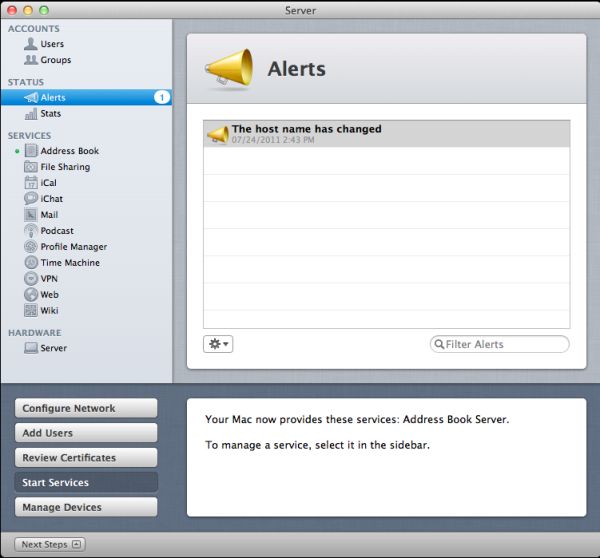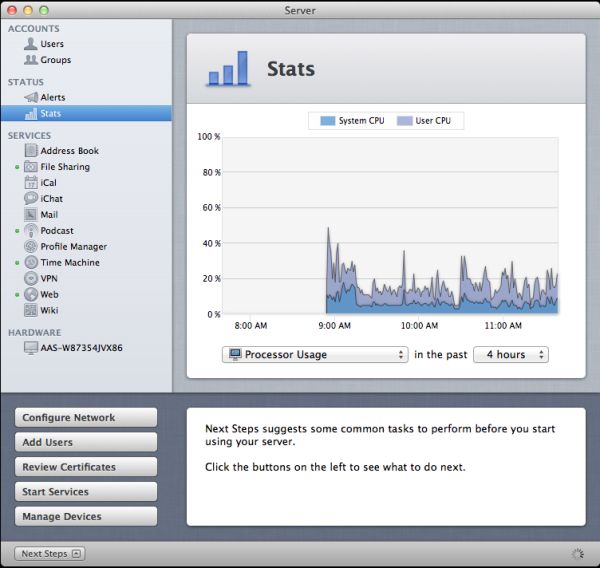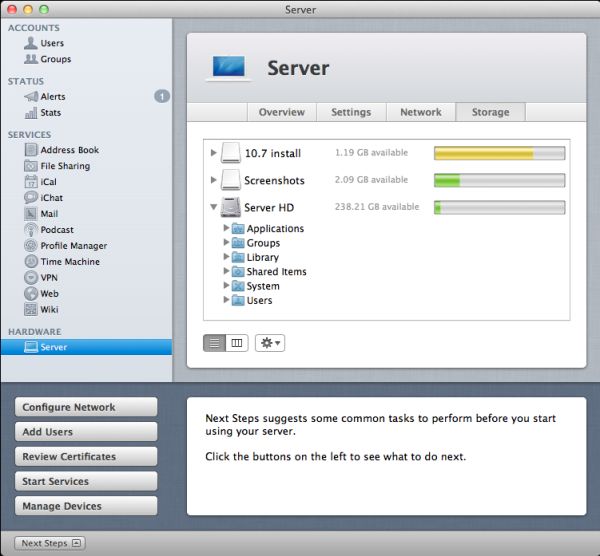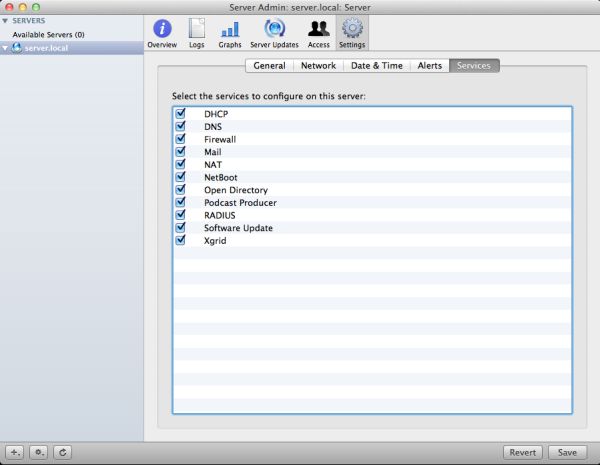In-Depth with Mac OS X Lion Server
by Andrew Cunningham on August 2, 2011 8:00 AM ESTServer.app Overview
Let’s start with Server.app, since it’s going to be the administration tool we’ll use the most throughout this review. I’ll start with a general overview of what it is and what it does, and then I’ll move on to the specific services that it manages.
For small and/or uncomplicated directories, Server.app will be fine for managing your directory, though people wanting to do anything more advanced will want to be familiar with Workgroup Manager (one of the Server Admin Tools that we’ll discuss in depth later).
Moving down the sidebar, our next entries are Alerts and Stats under the Status heading. Alerts is a simple log viewer, showing you messages about your server that you should know (if you have Server.app in your dock, the number of Alerts you have will be displayed with the icon).
Next, under Services, is a full list of every service manageable by Server.app - most of these offer up big on-off switches (I can hear seasoned admins grinding their teeth at this) and some basic configuration options which vary from service to service - we’ll talk more about the available options for each service as we discuss them.
Last up is the Hardware section, which lets you do quite a few things. The Overview tab gives you basic information about your server’s hardware and uptime.
Under the Settings tab, you can enable and disable SSH and remote administration of your server, create and control SSL certificates, and “dedicate system resources to server services,” which enhances the performance of some server functions at the expense of “the performance of some user applications” (this would be a useful box to tick on a dedicated server, but not on a personal computer that’s doing double-duty as a workstation).
Under the Network tab, you can see your server’s various network interfaces and their IP addresses, and you can also change your server’s host name (which is nice, since changing the host name used to require digging around in Server Admin and/or some command line trickery, depending on what you were doing).Lastly, the Storage tab gives you an overview of your available disk space, and also allows you to change the access permissions on files and folders (useful if you have file-sharing enabled, though you should probably do this using the File Sharing service itself, since it is much better at it).
Lastly, at the bottom of the screen, you can see something called Next Steps - this is an excellent place for novices to figure out what to do now that they’ve setup a server. It will guide you through setting up your network, managing network accounts, managing devices, and starting services, among a few other things. Those needing more advanced help can go through the documentation for Lion Server - the page is looking a little sparse right now, especially when compared to the extensive documentation for previous OS X Server versions, but hopefully it will become a little more populated over time.
Lastly, let’s talk about remote administration - if your OS X servers are located in a server room where you don’t have physical access to them, you’ll need a way to manage them remotely. In past OS X Server versions, the Server Admin Tools were installable to any OS X client, and enabled remote administration of most services and tasks.
Server.app, however, is not available for client OS X versions - if you need to administer Lion Server remotely, you’ll either need to change your OS X client into a server (thus giving you access to Server.app, which can be used to connect to other servers), or you must control your servers directly using VNC or Screen Sharing or Apple Remote Desktop (take your pick). It’s not a deal-breaking change, but businesses (whose Lion licensing terms are a bit less generous than those for consumers) will have to cough up for additional Server licenses if they want their admins to administer services on their servers.
We’ll look at the individual Server.app services soon - first, I want to walk you through the Server Admin program and OS X Server’s directory services, since so many of the other services are dependent on them.
Server Admin Overview
As we talked about before, Server Admin used to be the heart of OS X Server. Its role in Lion, while much reduced, is still important, since it still manages some of the software’s more interesting pieces.
Server Admin can still be installed to Lion clients and used to administer Lion Server (and Snow Leopard Server) remotely.
Now, time to talk about some services.

















77 Comments
View All Comments
the_engineer - Thursday, August 4, 2011 - link
Indeed, and that's the plan, assuming nothing else I like more comes along. I was really sort of tantalized by the possibility of software RAID in OSX, and still haven't been able to get a straight answer on it. Currently it is looking like it's a no go.tff - Tuesday, August 2, 2011 - link
As a home user, I've been frustrated by the inability to have two users edit a shared calendar in OS X/iOS without using 3rd party software.How would it differ using Lion server to accomplish this rather than Lion and iOS 5 clients using iCloud?
Typical Mac home user- iPhones, iPads, Mac laptops.
Omegabet - Tuesday, August 2, 2011 - link
You can install server.app on a client. Just copy the app over from the server. The first time you launch it, choose connect to a server. It will then run server.app from your client. Otherwise it will upgrade lion to the server version. This was recommended in the apple documentation (can't remember where though).qiankun - Tuesday, August 2, 2011 - link
One instance I found frustrating is that non-HSF+ volumes like NTFS and exFat cannot be accessed from other computers using SMB or AFP. You can add the volume to the file sharing list, pick whatever protocol you like, but when you try to access it you'll get an error. Same thing applies to the bootcamp partition.I like to use NTFS or exFat on external drives, for simple fact that whenever needed you can simply disconnect them from the mac server and plug into a PC. I know there are software that allows reading HSF+ partitions on windows, but it's not installed everywhere, very unlikely if you want to use the drive on a random computer you or your friend uses.
damianrobertjones - Tuesday, August 2, 2011 - link
Windows Home Server. That's all I have to add.justinf79 - Friday, August 5, 2011 - link
WHS isn't even in the same league...rs2 - Tuesday, August 2, 2011 - link
I've used a number of different wiki solutions, and the one included on OS X Server is a toy compared to most other popular wikis. There's just no comparison between the OS X wiki and something like Confluence or MediaWiki.gamoniac - Tuesday, August 2, 2011 - link
At first glance, this looks impressive, given the price tag and the myriad of features provided. However, the author should note the huge maintenance costs of this at best rudimentary product. Anyone who has used Apache or IIS 7 knows the Lion web server is years away from catching up.What good is a cheap product if you have to to spend, say, 40 hours, trying to get something to work. The TCO is too high even at $10/hour, and even for home users.
gamoniac - Tuesday, August 2, 2011 - link
PS: Good article nonetheless. Thank you AT. Keep them coming!repoman27 - Wednesday, August 3, 2011 - link
What's good about a cheap product with a myriad of features is that if even one or two work as advertised out of the box, it was worth it. If not, you're only out $50. I configured Snow Leopard Client on a MacBook Pro to work as a NetBoot / NetRestore server because I happened to find that functionality useful, and although it was trivial to do so, I'm perfectly inclined to shell out the $50 for Lion Server going forward rather than monkey around with another client version.In general, you're right though, it's stupid to cheap out on a capital expenditure and then spend an order of magnitude more trying to get someone who knows what they're doing to make it work.
Really, though, who doesn't spend at least 40 hours setting up a new server for the first time?